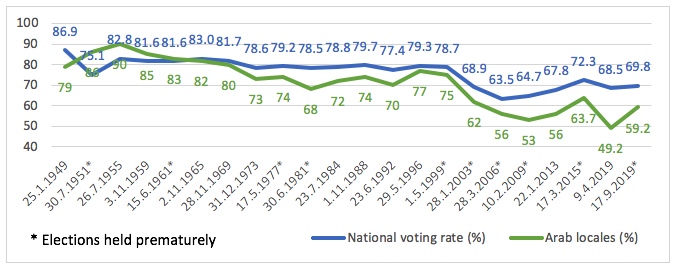Elections in Israel are held by law every four years but since 1999, six out of eight elections have been held prematurely due to a variety of political disputes.
Citizens vote for a party to serve on the Knesset (the 120-member Israeli Parliament). Since no single party receives a full majority, coalition-building negotiations follow the elections. The President (a symbolic office; the head of the State is the Prime Minister) appoints the leader of the party with most chance of forming a coalition, and a few weeks of negotiations are provided. If the process fails, the President appoints someone else; another failure will result in new elections. Since the largest parties in the past several years manage to get only 25-30% of the seats, this can get quite complicated. In the April 2019 elections, Prime Minister Netanyahu was appointed as the coalition builder, but failed to reach 61 members, and the country under went another election in September 2019, for which negotiations are still under way.
The parties
Israel is a multi-cultural country, comprising several social groups with different views: Jews and Arabs, the whole range from atheists to ultra-orthodox, immigrants or their progeny originating from every imaginable country in the world – Middle Eastern, West European, East European, African. It is a micro-cosmos of value systems and beliefs that has not yet reached equilibrium. Much as a teenager, the country can be charming at times, volatile at others.
Although founded as a socialist country, since 1977 the country has been ruled for most years by a right-wing party (Likud). The traditional division of Left vs. Right in most countries is based on economic values; in Israel, in contrast, it is based mainly on issues regarding the Israeli-Arab conflict in general, and the way to deal with the Israeli-Palestinian conflict (West Bank and Gaza) in particular.
There are usually two large competing parties – the Right-wing Likud, and a center-left party which may change form and name, but currently is the Blue-White party. However, there are several other parties that hold power, due to the coalition system. These can be defined by the sectors they represent:
- Arabs: voting-age Arabs are about 17% of the electorate. The Arab parties tend to unite to avoid not passing the minimum threshold. These parties are “counted” in the Center-Left wing group but have not been an official part of any coalition to date.
- Ultra-Orthodox Jews: there are two parties that represent this segment – Ashkenazi, originating in Europe and Sephardi, originating in Middle Eastern/North African countries. They are traditionally part of the right-wing coalitions.
- Settlers and nationalistic religious Jews: although names change, there is always a party that is ultra-right-wing representing this group.
- Left-wing: 1-2parties that represent values of equality and a two-State solution.
- FSU immigrants: a significant percentage of the electorate are Jews that immigrated to Israel since 1989. The party that represents them tends to be right wing.
Political surveys
Political surveys create great interest. A few weeks before the elections, political surveys are presented twice a week on TV and radio, newspapers and digital media.
Election day exit polls broadcasts are especially popular and provide a cumulative measure of 49.6 TV rating points.
Political surveys are regulated by the Elections Commissioner’s Office (ECO) and the main regulations are:
- Prior to the elections, all survey results that are to be published in any media must be sent to the ECO, with detailed descriptions regarding methodology, raw results, response rate, etc. The ECO will only confirm publication of surveys conducted under accepted methodologies.
- The results for any political party that reached over 1% in the survey must be published.
- Starting on the last Friday before election day, surveys may not be published.
- On election day, the three main broadcasting channels can hold exit polls, executed by a well-known research company. Each of these bodies is allowed to sample 60-70 ballot stations (out of about 10,000). The chosen sample of ballots requires the confirmation of the ECO. Exit polls are separate from the actual poll, and participation is voluntary.
- Exit poll results can be revealed only after final closing time of all ballot stations.
The main challenges in estimating the outcome of elections are numerous:
- Estimating voting rates by segments: voting rates fluctuate wildly (see Figure 1) and are biased, since certain segments tend to be represented differently. Exact figures are not available, since ballot stations may be mixed, but when comparing Arab-only locales to the national figures, lower voting rates are evident. The sharp increases in 2015 and Sep. 2019 are attributed to the merging of all Arab parties into one (in April 2019 there was a split into two parties). On the other hand, ultra-orthodox communities tend to demonstrate very high voting rates, estimated between high 70’s to low 80’s.
Figure 1: Voting rates – General population vs. Arab locales

- Calculating minimum threshold results – The minimum threshold for entrance is 3.25%. In the April 2019 elections, 8.5% of the votes were for parties that didn’t pass the threshold (the largest had 3.22%); in September 2019, this figure fell to 2.8%. This figure must be taken into account to estimate final results, but the estimations for small parties are prone to a dangerous margin of error.
- Pre-election agreements between pairs of parties determine which will receive an additional member based on remaining seat “fractions”. A tiny margin of error on seat fractions can lead to a +/- 1 error.
- Some segments in the Israeli population, mainly immigrants from the FSU and ultra-orthodox Jews, are hard to reach or tend not to cooperate in surveys and exit polls.
- Some party activists try to manipulate survey results to try to help their party (usually trying to show lower rates for their party, to encourage supporters to get out and vote).
- Absentee votes are counted separately and cannot be sampled; most are of soldiers on active duty (with a compulsory draft in Israel, a large percentage of the 18-22 cohorts do not vote in their residence ballots).
Pre-election surveys
Most of the pre-election surveys are done via online panels, with some additional CATI boosters (mainly Arabs and ultra-orthodox respondents, who tend to be under-represented in panels). Panels have proved to be very accurate in the last two elections, despite the self-selection bias typical of this methodology. Landline phones coverage is 65% (and decreasing), as opposed to Internet access and mobile phone coverage, which are both over 90%. Non-panel mobile phone interviews – whether moderated or text-based – tend to result in very low response rates, and thus very tentative samples.
Although resulting in excellent representative samples, face-to-face interviews are less in use for election period surveys, since the cost and timetable involved are prohibitive.
Sampling (and weighting) are usually based on a combination of demographic variables and past voting.
Most of the pre-election surveys conducted 4-6 days before the September elections were quite similar to each other (taking into account sampling errors) and gave quite good estimates. The main difference between estimates and actual results stemmed from assuming that the Extreme-Right Otzma Yehudit party would cross the threshold, which it didn’t.
Table 1. Number of Knesset Members by parties (totaling 120) – surveys conducted 4-6 days prior to the September 2019 elections
| True results | Kan 11 (TV) (Kantar) | Keshet 12 (TV) (Midgam) | Reshet 13 (TV) (Camil Fuchs) | Israel Today (Print) (Panels) | |
| Blue – White | 33 | 33 | 32 | 33 | 31 |
| Likud | 32 | 31 | 32 | 32 | 33 |
| Joint Arab Party | 13 | 11 | 10 | 12 | 12 |
| Shas | 9 | 7 | 7 | 6 | 7 |
| United Torah Judaism | 7 | 8 | 8 | 7 | 7 |
| Israel Beiteinu | 8 | 7 | 8 | 9 | 9 |
| Yamina | 7 | 9 | 8 | 9 | 7 |
| Meretz – Democratic Israel | 5 | 5 | 6 | 5 | 4 |
| Labor – Gesher | 6 | 5 | 5 | 4 | 6 |
| Otzma Yehudit | 0 | 4 | 4 | 4 | 4 |
Exit Polls
Exit polls are conducted in a way similar to actual voting: adjacent to the sampled ballot station, voters are asked to repeat the exact procedure of the true ballot. A curtain identical to the one in the true ballot enables confidentiality.
The ballot station research team is responsible for opening the envelopes, counting the votes, and sending the results for analysis. Since final results are published at exactly 10 pm, the last count is usually held around 9:00 pm, so late voters are not sampled.
The estimates provided by the different research teams were close to each other, and almost similar to the final election results (see Table 2).
Table 2. Number of Knesset Members by parties (totaling 120) – exit polls, September 2019 elections
| True results | Kan 11 (TV) (Kantar) | Keshet 12 (TV) (Midgam) | Reshet 13 (TV) (Camil Fuchs) | |
| Blue – White | 33 | 32 | 34 | 33 |
| Likud | 32 | 31 | 33 | 31 |
| Joint Arab Party | 13 | 13 | 11 | 13 |
| Shas | 9 | 9 | 8 | 9 |
| United Torah Judaism | 7 | 8 | 8 | 8 |
| Israel Beiteinu | 8 | 9 | 8 | 8 |
| Yamina | 7 | 7 | 8 | 6 |
| Meretz – Democratic Israel | 5 | 5 | 5 | 6 |
| Labor – Gesher | 6 | 6 | 5 | 6 |
| Otzma Yehudit | 0 | 0 | 0 | 0 |


